Redcliffe, Queensland
| Redcliffe Queensland | |||||||||||||||
|---|---|---|---|---|---|---|---|---|---|---|---|---|---|---|---|
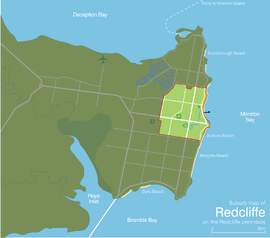 | |||||||||||||||
| Population | 10,373 (2016 census)[1] | ||||||||||||||
| Established | 13 September 1824 | ||||||||||||||
| Postcode(s) | 4020 | ||||||||||||||
| Location | 28 km (17 mi) NNE of Brisbane CBD | ||||||||||||||
| LGA(s) | Moreton Bay Region | ||||||||||||||
| State electorate(s) | Redcliffe | ||||||||||||||
| Federal Division(s) | Petrie | ||||||||||||||
| |||||||||||||||
Redcliffe is a residential suburb of the Brisbane metropolitan area located within Moreton Bay Region LGA in the east north-east of the Redcliffe peninsula, approximately 28 kilometres (17 mi) north-north-east of the Brisbane CBD. It serves as the Central Business District for the Redcliffe Peninsula and its surrounding suburbs.
Redcliffe is part of the statistical division of Brisbane. The town's name originates from "Red Cliff Point" named by the explorer John Oxley, referring to the red cliffs at Woody Point. Redcliffe became Queensland's first colony in 1824; however, it was soon abandoned for Brisbane. Since the 1880s, Redcliffe has been a popular seaside resort location due to its proximity to Brisbane. It is served by a small general aviation airfield, Redcliffe Airport (ICAO: YRED), located 2.5 nautical miles (4.6 km; 2.9 mi) northwest of Redcliffe in the suburb of Rothwell.
Demographics
In the 2011 census, the population of Redcliffe was 9,201; 52% female and 48% male.[2] The median age of the Redcliffe population was 44 years of age, 7 years above the Australian median. Children aged under 15 years made up 15.5% of the population and people aged 65 years and over made up 20.7% of the population. 68.4% of people living in Redcliffe were born in Australia, compared to the national average of 69.8%; the next most common countries of birth were England 7%, New Zealand 6.3%, Scotland 1%, Philippines 0.8%, Netherlands 0.7%. 86.8% of people spoke only English at home; the next most popular languages were 0.5% Italian, 0.4% Tagalog, 0.4% German, 0.3% Dutch, 0.3% Samoan.[2]
History
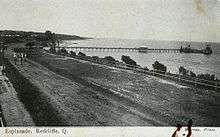
Before European settlement, the Redcliffe Peninsula was occupied by the indigenous Ningy Ningy people. The native name is Kau-in-Kau-in, which means Blood-Blood (red-like blood).[3]
Redcliffe holds the distinction of being the first European settlement in Queensland, first visited by Matthew Flinders on 17 July 1799.[4] Explorer John Oxley recommended "Red Cliff Point" – named after the red-coloured cliffs visible from Moreton Bay – to the Governor Thomas Brisbane for the new colony, reporting that ships could land at any tide and easily get close to the shore.[5] The party settled in Redcliffe on 13 September 1824, under the command of Lieutenant Henry Miller with 14 soldiers, some with wives and children, and 29 convicts. However, this settlement was abandoned after one year and the colony was moved south to a site on the Brisbane River at North Quay, 28 km (17 mi) south, that offered a more reliable water supply.
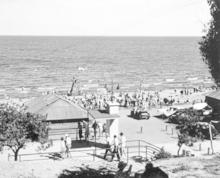
Redcliffe became a pastoral district in the 1860s and in the 1880s boomed as a seaside resort town with the twin screw excursion steamer Koopa making regular trips to its jetty from 1911. The principal route for passengers was a steamer from Sandgate pier to Woody Point Pier. The Hornibrook Bridge connecting Clontarf in the Town of Redcliffe to Brighton in City of Brisbane was completed in 1935 and allowed easy access to and from Brisbane by motor car leading the way to rapid suburban development.[6] That led to the cessation of the Sandgate to Woody Point steamers.
A famous Ningy Ningy Bora ring structure, consisting of two separate rings, large and small, joined by a ritual pathway, once existed between Kippa Ring and Anzac Avenue. Aboriginals as far away as Noosa would travel there to perform initiation ceremonies. It was razed by the Council around 1950.[7]
In 1958, the Gibb family from Manchester, England emigrated to this area and called it home for a period. Barry, Robin and Maurice Gibb went on to form the highly successful music group, The Bee Gees. In 1959, Brisbane based Speedcar driver Bill Goode, the promoter of the Redcliffe Speedway (located at the Redcliffe Showgrounds) hired the brothers to entertain the crowds at the speedway from the back of a truck during the interval. This was the first ever public performance by the trio.[8] In a letter to the Redcliffe Museum in 1999, Barry Gibb wrote "The smell of the oil, the noise and the atmosphere was incredible. This was the first public appearance Robin, Maurice and I ever made in Australia. We sang through the PA system and people threw money onto the track, and we met Brisbane's leading DJ and racing car driver Bill Gates, who suggested we call ourselves the BG's and even played our songs on his radio show, "Swinging' Gates' Platter Chatter". Hence Redcliffe became the birthplace of the Bee Gees."
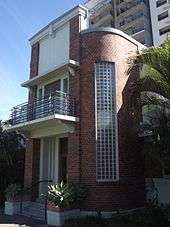
The first high-rise apartment building was constructed along Marine Parade in 1974.[9] For decades the interest for similar development was limited – until 2000 there were only four apartment buildings higher than 6 stories across the entire Peninsula. Renewed interest in Redcliffe as a seaside lifestyle precinct occurred in the 2000s and 2010s and as a result high rise and mix use development is found in all areas of Redcliffe along the coastline.
In 1975, the toll on the Hornibrook Highway was removed.[9]
The Redcliffe Library opened in 2000.[10]
Heritage listings
Redcliffe has a number of heritage-listed sites, including:
- Anzac Memorial Avenue[11]
- 395 Oxley Avenue: Redcliffe Fire Station[12]
- 133-137 Redcliffe Parade: Comino's Arcade[13]
- 185 Redcliffe Parade: former Redcliffe Town Council Chambers[14]
Attractions and features
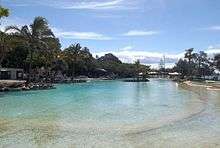
Attractions such as Suttons Beach(location of Luna Park Redcliffe(1944 to 1966)[15][16]), Redcliffe Jetty, Settlement Cove Lagoon, Redcliffe Museum, Redcliffe Botanic Gardens and Redcliffe Showgrounds are all within the suburb of Redcliffe. The entire Redcliffe Parade precinct is home to an abundance of restaurants and eateries including the award-winning Rustic Olive Italian restaurant and the Mon Komo hotel. On Sundays, the Jetty Markets take place along Redcliffe Parade and in recent years have been a significant event for local businesses with crowds of thousands taking part.
Aside from smaller events, in September each year, Redcliffe celebrates its history as Queensland's first European settlement location with the Redcliffe festival event. This festival is chiefly held in the Redcliffe CBD with Redcliffe Parade being closed off to traffic for most of the day. Other attractions as part of this festival include the KiteFest, The Jetty Fiesta, KiteFest Live and Spring Break Beach Party with ongoing interest from local community groups and sponsors to create larger and more attractive events each year.
A statue and walkway in honour of the Bee Gees was unveiled by Barry Gibb on 14 February 2013. Barry returned to open the second stage of the walkway on 9 September 2015.[17]
The Moreton Bay Regional Council operates a public library at 476 Oxley Avenue.[18]
Education
- Southern Cross Catholic College
- Redcliffe State High School opened in 1958[19]
- Redcliffe Special School opened in 1964[19]
Sport and recreation
A number of well-known sporting teams represent the local area. Some of them are the well known Sandgate-Redcliffe Gators, Redcliffe Dolphins, Redcliffe Tigers and Redcliffe Padres. Redcliffe hosts the only harness racing in Queensland that is North of Brisbane at the Redcliffe Harness Racing & Sporting Club.[20]
References
- ↑ Australian Bureau of Statistics (27 June 2017). "Redcliffe (Qld) (State Suburb)". 2016 Census QuickStats. Retrieved 19 April 2018.

- 1 2 Australian Bureau of Statistics (31 October 2012). "Redcliffe (Qld) (State Suburb)". 2011 Census QuickStats. Retrieved 26 October 2014.

- ↑ Petrie, Constance Campbell; Petrie, Tom, 1831–1910 (1992). Tom Petrie's reminiscences of early Queensland (4th ed.). University of Queensland Press. p. 317. ISBN 978-0-7022-2383-9.
- ↑ "Redcliffe". Travel. The Sydney Morning Herald. 8 February 2004. Retrieved 17 May 2008.
- ↑ Potter, Ron. "Place Names of South East Queensland". Piula Publications. Archived from the original on 23 May 2008. Retrieved 17 May 2008.
- ↑ "HORNIBROOK HIGHWAY OPENED". The Courier-Mail. Brisbane. 5 October 1935. p. 15. Retrieved 28 June 2015 – via National Library of Australia.
- ↑ Steele 1984, p. 165.
- ↑ Van Extel, Cathy (13 February 2013). "Bee Gees first promoter tells about band's early days in Australia". Australian Broadcasting Corporation. Retrieved 14 February 2014.
- 1 2 "Buildings, Structures and Memorials" (PDF). Redcliffe Historical Timeline. Moreton Bay Regional Council. 2008. Retrieved 7 September 2016.
- ↑ "Queensland Public Libraries Statistical Bulletin 2016-2017" (PDF). Public Libraries Connect. State Library of Queensland. November 2017. p. 14. Retrieved 26 January 2018.
- ↑ "Anzac Memorial Avenue (former) (entry 602693)". Queensland Heritage Register. Queensland Heritage Council. Retrieved 11 July 2013.
- ↑ "Redcliffe Fire Station (entry 602548)". Queensland Heritage Register. Queensland Heritage Council. Retrieved 11 July 2013.
- ↑ "Comino's Arcade (entry 602692)". Queensland Heritage Register. Queensland Heritage Council. Retrieved 11 July 2013.
- ↑ "Redcliffe Town Council Chambers (former) (entry 601567)". Queensland Heritage Register. Queensland Heritage Council. Retrieved 11 July 2013.
- ↑ Redcliffe Historical Timeline Archived 15 February 2012 at the Wayback Machine. – Moreton Bay Regional Council
- ↑ "REDCLIFFE LUNA PARK TAX FREE". The Courier-Mail (3437). Brisbane. 12 September 1944. p. 3. Retrieved 31 March 2017 – via National Library of Australia.
- ↑ "Barry Gibb returns to Redcliffe to unveil stage two of Moreton Bay Regional Council's Bee Gees Way". www.couriermail.com.au. News Corp. 11 September 2015. Retrieved 12 September 2015.
- ↑ "Redcliffe Library". Public Libraries Connect. State Library of Queensland. 5 October 2017. Retrieved 26 January 2018.
- 1 2 "Opening and closing dates of Queensland schools". Department of Education and Training. Queensland Government. 1 August 2013. Retrieved 26 January 2017.
- ↑ "Redcliffe Harness Racing & Sporting Club Inc". Retrieved 21 July 2015.
- Steele, John Gladstone (1984). Aboriginal Pathways: in Southeast Queensland and the Richmond River. University of Queensland Press. ISBN 978-0-702-25742-1.
External links
| Wikimedia Commons has media related to Redcliffe, Queensland. |
Coordinates: 27°13′33″S 153°06′23″E / 27.2258°S 153.1063°E